Project Management Case Study: Analysis of Oil Company Project
VerifiedAdded on 2023/06/07
|11
|1864
|418
Case Study
AI Summary
This case study analyzes the project management strategies employed by a multinational oil company to repair oil tanks at its Western Australian site, aiming to reduce environmental fines and improve tank availability. The project goals include timely tank repair completion within budget and a reduction in environmental fines. The scope encompasses tank repairs and increasing tank availability, while excluding supplier details. Key stakeholders include the project manager, planner, supervisor, contractor, construction manager, and finance manager. Deliverables involve repairing specific tanks with varying capacities, and resolving site-related challenges. The project utilizes the Agile methodology, emphasizing continuous testing and quality analysis. Monitoring and controlling processes involve schedule management, quality control, and risk management, with project success measured by reduced environmental fines, timely completion, proper tank repair, and enhanced tank availability. Desklib offers more solved assignments and resources for students.

Running head: PROJECT MANAGEMENT
Case Study: Multinational Oil company
Name of the Student
Name of the University
Author’s Note
Case Study: Multinational Oil company
Name of the Student
Name of the University
Author’s Note
Paraphrase This Document
Need a fresh take? Get an instant paraphrase of this document with our AI Paraphraser
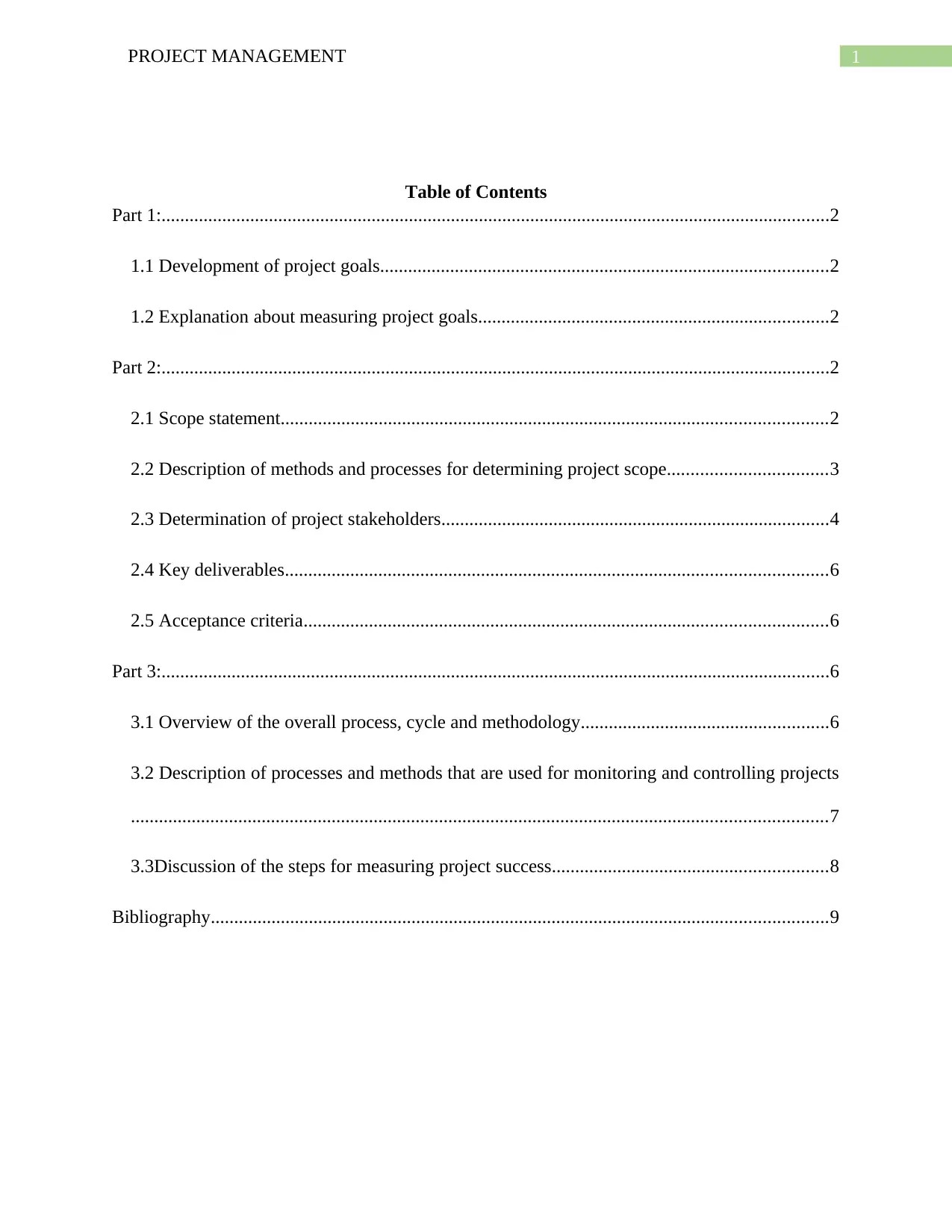
1PROJECT MANAGEMENT
Table of Contents
Part 1:...............................................................................................................................................2
1.1 Development of project goals................................................................................................2
1.2 Explanation about measuring project goals...........................................................................2
Part 2:...............................................................................................................................................2
2.1 Scope statement.....................................................................................................................2
2.2 Description of methods and processes for determining project scope..................................3
2.3 Determination of project stakeholders...................................................................................4
2.4 Key deliverables....................................................................................................................6
2.5 Acceptance criteria................................................................................................................6
Part 3:...............................................................................................................................................6
3.1 Overview of the overall process, cycle and methodology.....................................................6
3.2 Description of processes and methods that are used for monitoring and controlling projects
.....................................................................................................................................................7
3.3Discussion of the steps for measuring project success...........................................................8
Bibliography....................................................................................................................................9
Table of Contents
Part 1:...............................................................................................................................................2
1.1 Development of project goals................................................................................................2
1.2 Explanation about measuring project goals...........................................................................2
Part 2:...............................................................................................................................................2
2.1 Scope statement.....................................................................................................................2
2.2 Description of methods and processes for determining project scope..................................3
2.3 Determination of project stakeholders...................................................................................4
2.4 Key deliverables....................................................................................................................6
2.5 Acceptance criteria................................................................................................................6
Part 3:...............................................................................................................................................6
3.1 Overview of the overall process, cycle and methodology.....................................................6
3.2 Description of processes and methods that are used for monitoring and controlling projects
.....................................................................................................................................................7
3.3Discussion of the steps for measuring project success...........................................................8
Bibliography....................................................................................................................................9
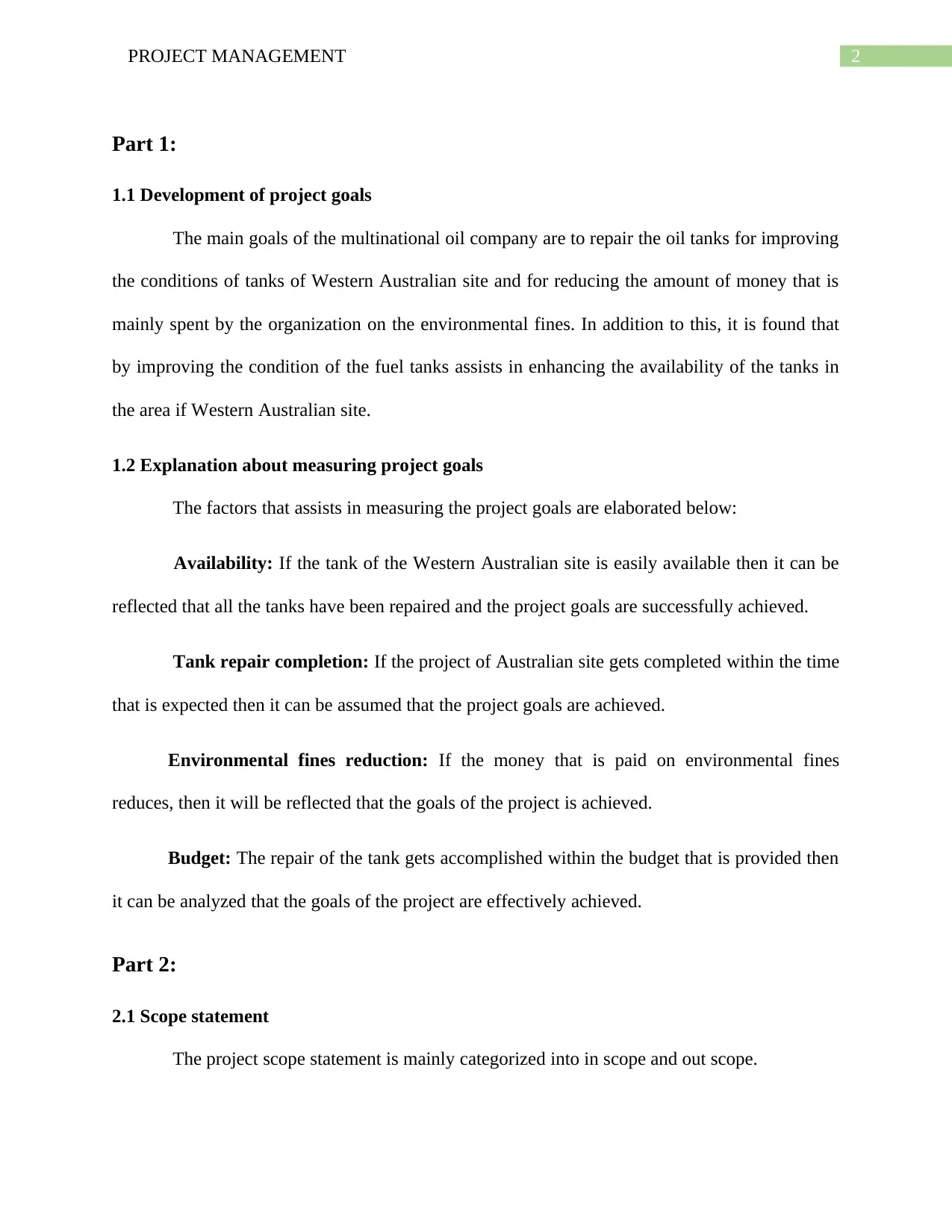
2PROJECT MANAGEMENT
Part 1:
1.1 Development of project goals
The main goals of the multinational oil company are to repair the oil tanks for improving
the conditions of tanks of Western Australian site and for reducing the amount of money that is
mainly spent by the organization on the environmental fines. In addition to this, it is found that
by improving the condition of the fuel tanks assists in enhancing the availability of the tanks in
the area if Western Australian site.
1.2 Explanation about measuring project goals
The factors that assists in measuring the project goals are elaborated below:
Availability: If the tank of the Western Australian site is easily available then it can be
reflected that all the tanks have been repaired and the project goals are successfully achieved.
Tank repair completion: If the project of Australian site gets completed within the time
that is expected then it can be assumed that the project goals are achieved.
Environmental fines reduction: If the money that is paid on environmental fines
reduces, then it will be reflected that the goals of the project is achieved.
Budget: The repair of the tank gets accomplished within the budget that is provided then
it can be analyzed that the goals of the project are effectively achieved.
Part 2:
2.1 Scope statement
The project scope statement is mainly categorized into in scope and out scope.
Part 1:
1.1 Development of project goals
The main goals of the multinational oil company are to repair the oil tanks for improving
the conditions of tanks of Western Australian site and for reducing the amount of money that is
mainly spent by the organization on the environmental fines. In addition to this, it is found that
by improving the condition of the fuel tanks assists in enhancing the availability of the tanks in
the area if Western Australian site.
1.2 Explanation about measuring project goals
The factors that assists in measuring the project goals are elaborated below:
Availability: If the tank of the Western Australian site is easily available then it can be
reflected that all the tanks have been repaired and the project goals are successfully achieved.
Tank repair completion: If the project of Australian site gets completed within the time
that is expected then it can be assumed that the project goals are achieved.
Environmental fines reduction: If the money that is paid on environmental fines
reduces, then it will be reflected that the goals of the project is achieved.
Budget: The repair of the tank gets accomplished within the budget that is provided then
it can be analyzed that the goals of the project are effectively achieved.
Part 2:
2.1 Scope statement
The project scope statement is mainly categorized into in scope and out scope.
⊘ This is a preview!⊘
Do you want full access?
Subscribe today to unlock all pages.

Trusted by 1+ million students worldwide
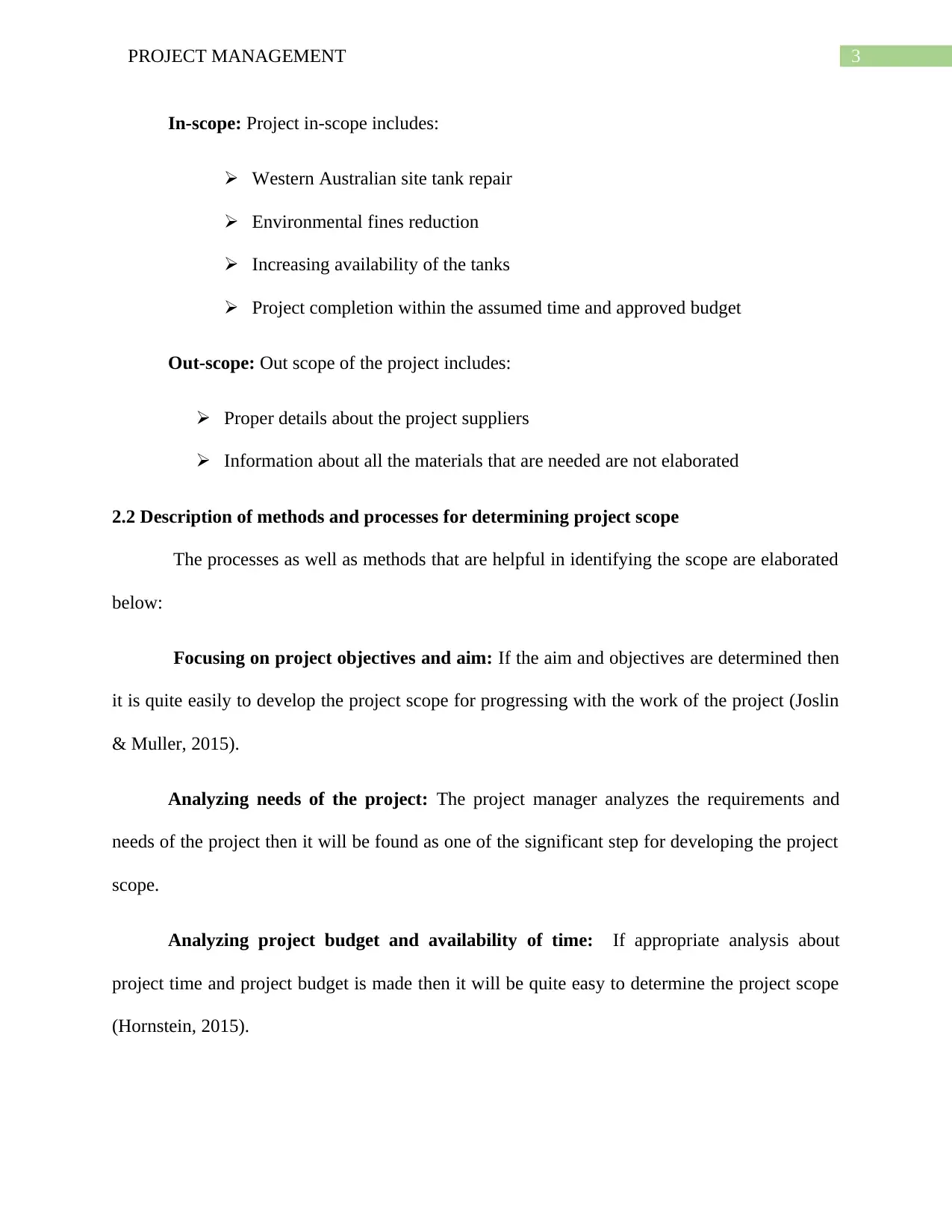
3PROJECT MANAGEMENT
In-scope: Project in-scope includes:
Western Australian site tank repair
Environmental fines reduction
Increasing availability of the tanks
Project completion within the assumed time and approved budget
Out-scope: Out scope of the project includes:
Proper details about the project suppliers
Information about all the materials that are needed are not elaborated
2.2 Description of methods and processes for determining project scope
The processes as well as methods that are helpful in identifying the scope are elaborated
below:
Focusing on project objectives and aim: If the aim and objectives are determined then
it is quite easily to develop the project scope for progressing with the work of the project (Joslin
& Muller, 2015).
Analyzing needs of the project: The project manager analyzes the requirements and
needs of the project then it will be found as one of the significant step for developing the project
scope.
Analyzing project budget and availability of time: If appropriate analysis about
project time and project budget is made then it will be quite easy to determine the project scope
(Hornstein, 2015).
In-scope: Project in-scope includes:
Western Australian site tank repair
Environmental fines reduction
Increasing availability of the tanks
Project completion within the assumed time and approved budget
Out-scope: Out scope of the project includes:
Proper details about the project suppliers
Information about all the materials that are needed are not elaborated
2.2 Description of methods and processes for determining project scope
The processes as well as methods that are helpful in identifying the scope are elaborated
below:
Focusing on project objectives and aim: If the aim and objectives are determined then
it is quite easily to develop the project scope for progressing with the work of the project (Joslin
& Muller, 2015).
Analyzing needs of the project: The project manager analyzes the requirements and
needs of the project then it will be found as one of the significant step for developing the project
scope.
Analyzing project budget and availability of time: If appropriate analysis about
project time and project budget is made then it will be quite easy to determine the project scope
(Hornstein, 2015).
Paraphrase This Document
Need a fresh take? Get an instant paraphrase of this document with our AI Paraphraser

4PROJECT MANAGEMENT
Reflecting on constraints and assumptions: It is found that information related with
constraints and assumptions of the project are found to be very much essential for determining
project scope.
2.3 Determination of project stakeholders
The stakeholders who are involved with the project are listed below:
Stakeholder Responsibilities Power Interest
Project manager The project
manager takes the
responsibility of
executing, managing
as well as initiating
the entire project of
repairing the fuel
tanks WA site.
High High
Project planner The project planner
takes the
responsibility of
creating proper plan
for executing the
entire project on
time.
Medium High
Supervisor The supervisor takes
the responsibility of
High Medium
Reflecting on constraints and assumptions: It is found that information related with
constraints and assumptions of the project are found to be very much essential for determining
project scope.
2.3 Determination of project stakeholders
The stakeholders who are involved with the project are listed below:
Stakeholder Responsibilities Power Interest
Project manager The project
manager takes the
responsibility of
executing, managing
as well as initiating
the entire project of
repairing the fuel
tanks WA site.
High High
Project planner The project planner
takes the
responsibility of
creating proper plan
for executing the
entire project on
time.
Medium High
Supervisor The supervisor takes
the responsibility of
High Medium

5PROJECT MANAGEMENT
supervising the
project activities in
order to repair the
tan of the project.
Contractor The contractor takes
the responsibility of
contract for finishing
the repair of the tank
within the expected
budget and time.
Medium High
Construction
manager
The construction
manager takes the
responsibility of
managing as well as
executing each of
the activities of the
project so that the
tank of Western
Australian tank can
be properly repaired.
High Medium
Finance manager The project financial
manager is mainly
responsible of
Medium Medium
supervising the
project activities in
order to repair the
tan of the project.
Contractor The contractor takes
the responsibility of
contract for finishing
the repair of the tank
within the expected
budget and time.
Medium High
Construction
manager
The construction
manager takes the
responsibility of
managing as well as
executing each of
the activities of the
project so that the
tank of Western
Australian tank can
be properly repaired.
High Medium
Finance manager The project financial
manager is mainly
responsible of
Medium Medium
⊘ This is a preview!⊘
Do you want full access?
Subscribe today to unlock all pages.

Trusted by 1+ million students worldwide
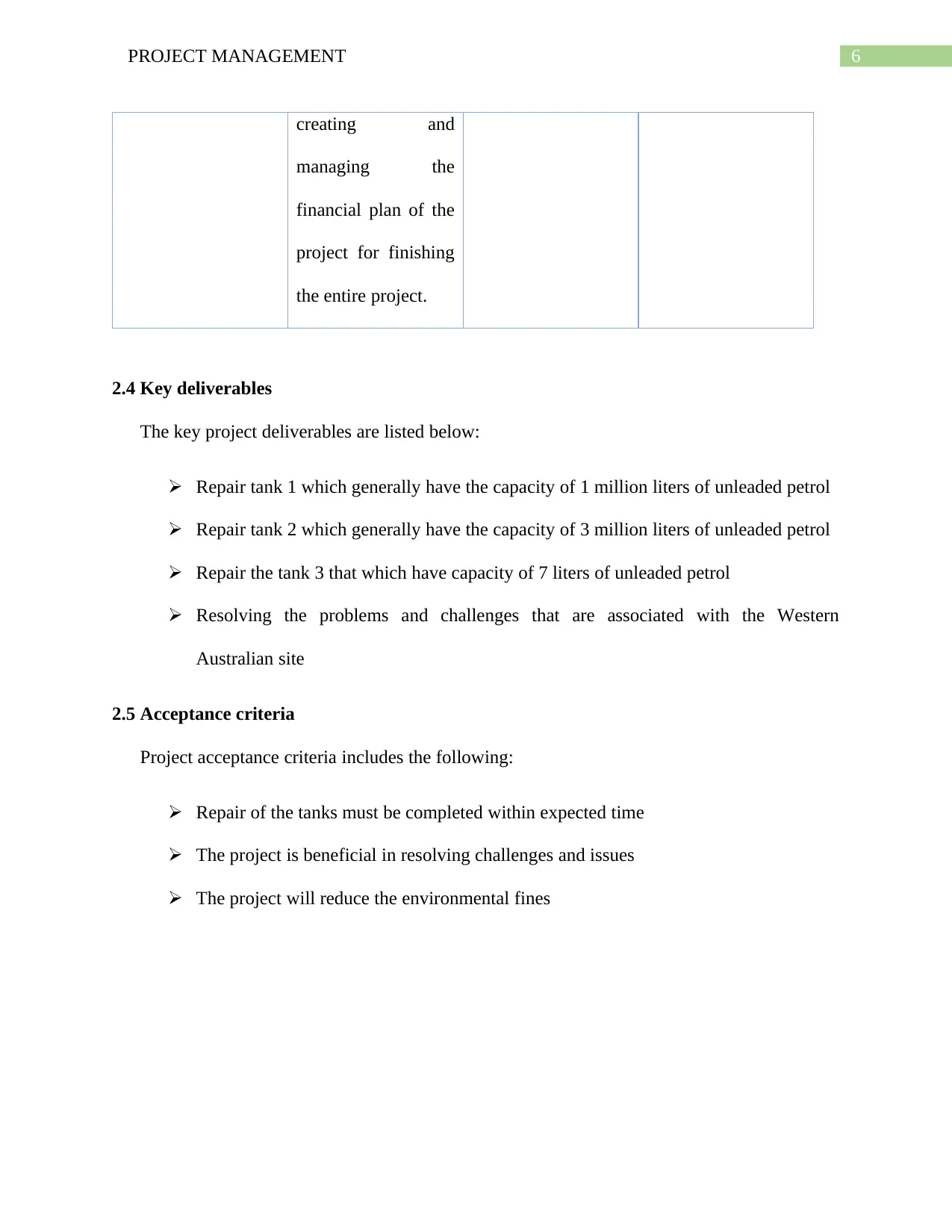
6PROJECT MANAGEMENT
creating and
managing the
financial plan of the
project for finishing
the entire project.
2.4 Key deliverables
The key project deliverables are listed below:
Repair tank 1 which generally have the capacity of 1 million liters of unleaded petrol
Repair tank 2 which generally have the capacity of 3 million liters of unleaded petrol
Repair the tank 3 that which have capacity of 7 liters of unleaded petrol
Resolving the problems and challenges that are associated with the Western
Australian site
2.5 Acceptance criteria
Project acceptance criteria includes the following:
Repair of the tanks must be completed within expected time
The project is beneficial in resolving challenges and issues
The project will reduce the environmental fines
creating and
managing the
financial plan of the
project for finishing
the entire project.
2.4 Key deliverables
The key project deliverables are listed below:
Repair tank 1 which generally have the capacity of 1 million liters of unleaded petrol
Repair tank 2 which generally have the capacity of 3 million liters of unleaded petrol
Repair the tank 3 that which have capacity of 7 liters of unleaded petrol
Resolving the problems and challenges that are associated with the Western
Australian site
2.5 Acceptance criteria
Project acceptance criteria includes the following:
Repair of the tanks must be completed within expected time
The project is beneficial in resolving challenges and issues
The project will reduce the environmental fines
Paraphrase This Document
Need a fresh take? Get an instant paraphrase of this document with our AI Paraphraser
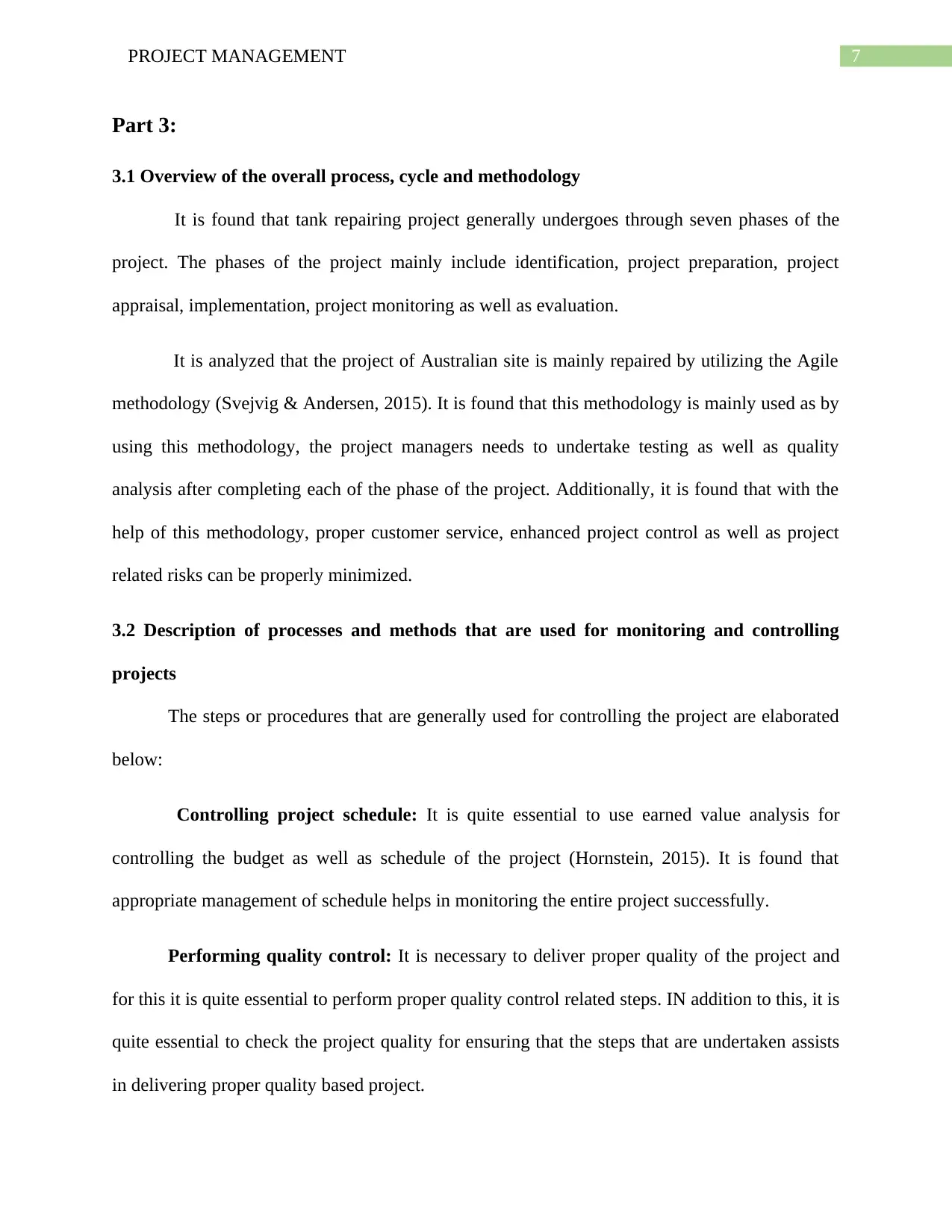
7PROJECT MANAGEMENT
Part 3:
3.1 Overview of the overall process, cycle and methodology
It is found that tank repairing project generally undergoes through seven phases of the
project. The phases of the project mainly include identification, project preparation, project
appraisal, implementation, project monitoring as well as evaluation.
It is analyzed that the project of Australian site is mainly repaired by utilizing the Agile
methodology (Svejvig & Andersen, 2015). It is found that this methodology is mainly used as by
using this methodology, the project managers needs to undertake testing as well as quality
analysis after completing each of the phase of the project. Additionally, it is found that with the
help of this methodology, proper customer service, enhanced project control as well as project
related risks can be properly minimized.
3.2 Description of processes and methods that are used for monitoring and controlling
projects
The steps or procedures that are generally used for controlling the project are elaborated
below:
Controlling project schedule: It is quite essential to use earned value analysis for
controlling the budget as well as schedule of the project (Hornstein, 2015). It is found that
appropriate management of schedule helps in monitoring the entire project successfully.
Performing quality control: It is necessary to deliver proper quality of the project and
for this it is quite essential to perform proper quality control related steps. IN addition to this, it is
quite essential to check the project quality for ensuring that the steps that are undertaken assists
in delivering proper quality based project.
Part 3:
3.1 Overview of the overall process, cycle and methodology
It is found that tank repairing project generally undergoes through seven phases of the
project. The phases of the project mainly include identification, project preparation, project
appraisal, implementation, project monitoring as well as evaluation.
It is analyzed that the project of Australian site is mainly repaired by utilizing the Agile
methodology (Svejvig & Andersen, 2015). It is found that this methodology is mainly used as by
using this methodology, the project managers needs to undertake testing as well as quality
analysis after completing each of the phase of the project. Additionally, it is found that with the
help of this methodology, proper customer service, enhanced project control as well as project
related risks can be properly minimized.
3.2 Description of processes and methods that are used for monitoring and controlling
projects
The steps or procedures that are generally used for controlling the project are elaborated
below:
Controlling project schedule: It is quite essential to use earned value analysis for
controlling the budget as well as schedule of the project (Hornstein, 2015). It is found that
appropriate management of schedule helps in monitoring the entire project successfully.
Performing quality control: It is necessary to deliver proper quality of the project and
for this it is quite essential to perform proper quality control related steps. IN addition to this, it is
quite essential to check the project quality for ensuring that the steps that are undertaken assists
in delivering proper quality based project.
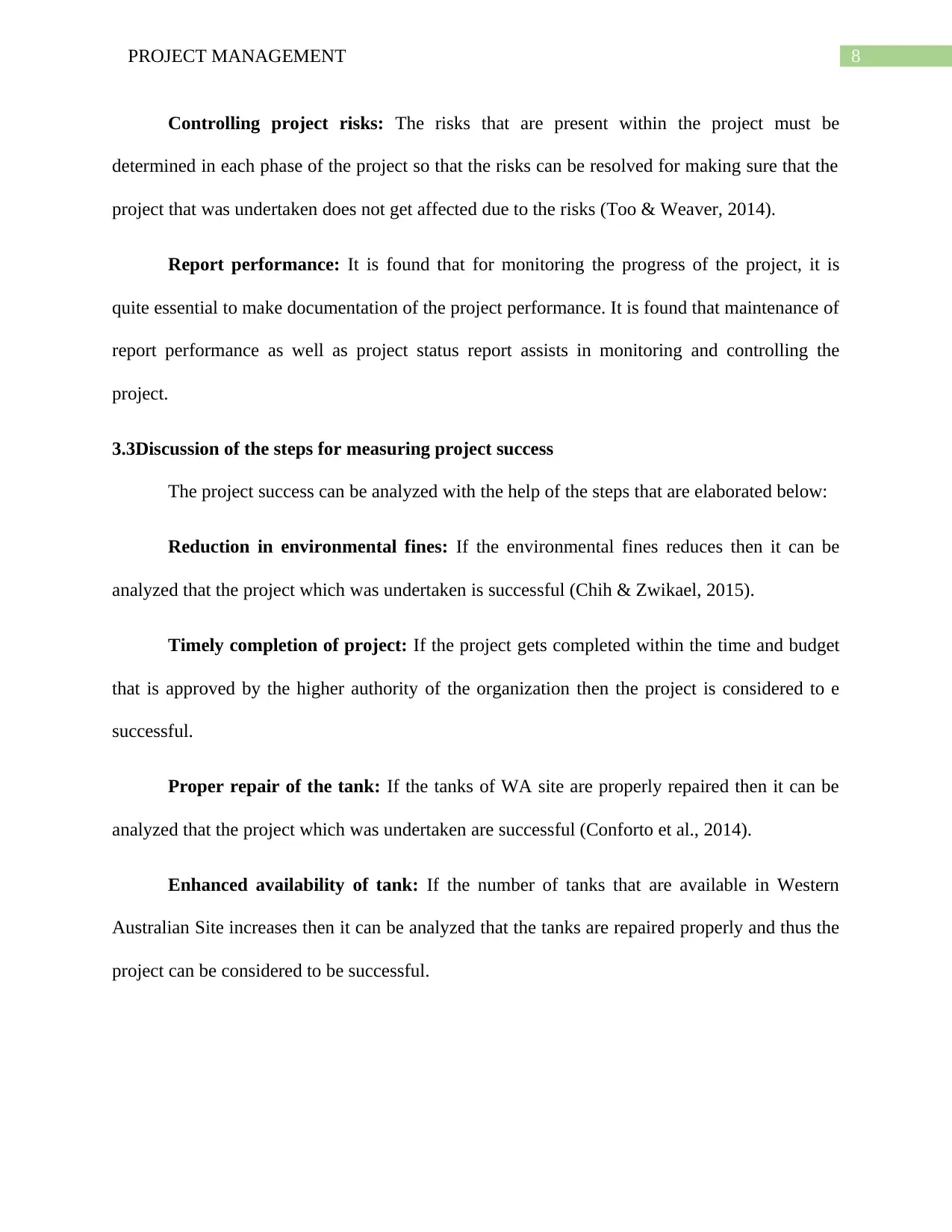
8PROJECT MANAGEMENT
Controlling project risks: The risks that are present within the project must be
determined in each phase of the project so that the risks can be resolved for making sure that the
project that was undertaken does not get affected due to the risks (Too & Weaver, 2014).
Report performance: It is found that for monitoring the progress of the project, it is
quite essential to make documentation of the project performance. It is found that maintenance of
report performance as well as project status report assists in monitoring and controlling the
project.
3.3Discussion of the steps for measuring project success
The project success can be analyzed with the help of the steps that are elaborated below:
Reduction in environmental fines: If the environmental fines reduces then it can be
analyzed that the project which was undertaken is successful (Chih & Zwikael, 2015).
Timely completion of project: If the project gets completed within the time and budget
that is approved by the higher authority of the organization then the project is considered to e
successful.
Proper repair of the tank: If the tanks of WA site are properly repaired then it can be
analyzed that the project which was undertaken are successful (Conforto et al., 2014).
Enhanced availability of tank: If the number of tanks that are available in Western
Australian Site increases then it can be analyzed that the tanks are repaired properly and thus the
project can be considered to be successful.
Controlling project risks: The risks that are present within the project must be
determined in each phase of the project so that the risks can be resolved for making sure that the
project that was undertaken does not get affected due to the risks (Too & Weaver, 2014).
Report performance: It is found that for monitoring the progress of the project, it is
quite essential to make documentation of the project performance. It is found that maintenance of
report performance as well as project status report assists in monitoring and controlling the
project.
3.3Discussion of the steps for measuring project success
The project success can be analyzed with the help of the steps that are elaborated below:
Reduction in environmental fines: If the environmental fines reduces then it can be
analyzed that the project which was undertaken is successful (Chih & Zwikael, 2015).
Timely completion of project: If the project gets completed within the time and budget
that is approved by the higher authority of the organization then the project is considered to e
successful.
Proper repair of the tank: If the tanks of WA site are properly repaired then it can be
analyzed that the project which was undertaken are successful (Conforto et al., 2014).
Enhanced availability of tank: If the number of tanks that are available in Western
Australian Site increases then it can be analyzed that the tanks are repaired properly and thus the
project can be considered to be successful.
⊘ This is a preview!⊘
Do you want full access?
Subscribe today to unlock all pages.

Trusted by 1+ million students worldwide

9PROJECT MANAGEMENT
Bibliography
Badewi, A. (2016). The impact of project management (PM) and benefits management (BM)
practices on project success: Towards developing a project benefits governance
framework. International Journal of Project Management, 34(4), 761-778.
Chih, Y. Y., & Zwikael, O. (2015). Project benefit management: A conceptual framework of
target benefit formulation. International Journal of Project Management, 33(2), 352-362.
Conforto, E. C., Salum, F., Amaral, D. C., da Silva, S. L., & de Almeida, L. F. M. (2014). Can
agile project management be adopted by industries other than software
development?. Project Management Journal, 45(3), 21-34.
Hornstein, H. A. (2015). The integration of project management and organizational change
management is now a necessity. International Journal of Project Management, 33(2),
291-298.
Joslin, R., & Müller, R. (2015). Relationships between a project management methodology and
project success in different project governance contexts. International Journal of Project
Management, 33(6), 1377-1392.
Kaiser, M. G., El Arbi, F., & Ahlemann, F. (2015). Successful project portfolio management
beyond project selection techniques: Understanding the role of structural
alignment. International Journal of Project Management, 33(1), 126-139.
Riol, H., & Thuillier, D. (2015). Project management for academic research projects: balancing
structure and flexibility. International Journal of Project Organisation and
Management, 7(3), 251-269.
Bibliography
Badewi, A. (2016). The impact of project management (PM) and benefits management (BM)
practices on project success: Towards developing a project benefits governance
framework. International Journal of Project Management, 34(4), 761-778.
Chih, Y. Y., & Zwikael, O. (2015). Project benefit management: A conceptual framework of
target benefit formulation. International Journal of Project Management, 33(2), 352-362.
Conforto, E. C., Salum, F., Amaral, D. C., da Silva, S. L., & de Almeida, L. F. M. (2014). Can
agile project management be adopted by industries other than software
development?. Project Management Journal, 45(3), 21-34.
Hornstein, H. A. (2015). The integration of project management and organizational change
management is now a necessity. International Journal of Project Management, 33(2),
291-298.
Joslin, R., & Müller, R. (2015). Relationships between a project management methodology and
project success in different project governance contexts. International Journal of Project
Management, 33(6), 1377-1392.
Kaiser, M. G., El Arbi, F., & Ahlemann, F. (2015). Successful project portfolio management
beyond project selection techniques: Understanding the role of structural
alignment. International Journal of Project Management, 33(1), 126-139.
Riol, H., & Thuillier, D. (2015). Project management for academic research projects: balancing
structure and flexibility. International Journal of Project Organisation and
Management, 7(3), 251-269.
Paraphrase This Document
Need a fresh take? Get an instant paraphrase of this document with our AI Paraphraser

10PROJECT MANAGEMENT
Svejvig, P., & Andersen, P. (2015). Rethinking project management: A structured literature
review with a critical look at the brave new world. International Journal of Project
Management, 33(2), 278-290.
Too, E. G., & Weaver, P. (2014). The management of project management: A conceptual
framework for project governance. International Journal of Project Management, 32(8),
1382-1394.
Svejvig, P., & Andersen, P. (2015). Rethinking project management: A structured literature
review with a critical look at the brave new world. International Journal of Project
Management, 33(2), 278-290.
Too, E. G., & Weaver, P. (2014). The management of project management: A conceptual
framework for project governance. International Journal of Project Management, 32(8),
1382-1394.
1 out of 11
Related Documents
Your All-in-One AI-Powered Toolkit for Academic Success.
+13062052269
info@desklib.com
Available 24*7 on WhatsApp / Email
![[object Object]](/_next/static/media/star-bottom.7253800d.svg)
Unlock your academic potential
Copyright © 2020–2025 A2Z Services. All Rights Reserved. Developed and managed by ZUCOL.




